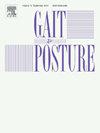双侧和单侧慢性踝关节不稳定个体的姿势控制和肌肉激活的差异
IF 2.4
3区 医学
Q3 NEUROSCIENCES
引用次数: 0
摘要
背景:慢性踝关节不稳定(CAI)患者表现出姿势控制和肌肉激活的缺陷,双侧变化表明中枢感觉运动功能的改变。然而,双侧和单侧CAI在姿势控制和肌肉激活方面的差异尚不清楚。了解这些差异对于制定有针对性的康复策略至关重要。研究问题:双侧CAI、单侧CAI和健康对照在姿势控制和肌肉激活方面有差异吗?方法选取18例双侧CAI患者(双侧)、18例单侧CAI患者(单侧)和18例健康对照(对照组)。为了评估压力中心(COP)和综合肌电图(iEMG),参与者进行了3次单腿站立任务试验,同时记录了下肢肌肉的激活情况。采用单因素方差分析来评估三组患者自我报告的功能结果、姿势控制和肌肉激活的差异。结果与单侧组和对照组相比,双侧组在COP中外侧速度和COP前后速度上的姿势控制较差。然而,单侧组表现出与对照组相似的姿势控制。与单侧组和对照组相比,双侧组在胫骨前肌显示更大的iEMG。与对照组相比,单侧组胫骨前肌的iEMG较低。双侧和单侧CAI个体在单腿站立时的姿势控制和肌肉激活方面存在显著差异,提示中枢神经系统对感觉运动功能的处理可能不同。了解这些差异可以指导个性化治疗,从而提高患者的治疗效果,减少复发性扭伤的风险。本文章由计算机程序翻译,如有差异,请以英文原文为准。
Differences in postural control and muscle activation in individuals with bilateral and unilateral chronic ankle instability
Background
Individuals with chronic ankle instability (CAI) exhibit deficits in postural control and muscle activation, with bilateral changes suggesting central alterations in sensorimotor function. However, differences in postural control and muscle activation between bilateral and unilateral CAI remain unclear. Understanding these differences is crucial for developing targeted rehabilitation strategies.
Research question
Do individuals with bilateral CAI, unilateral CAI, and healthy controls have differences in postural control and muscle activation?
Methods
18 individuals with bilateral CAI (bilateral), 18 individuals with unilateral CAI (unilateral), and 18 healthy controls (control) were recruited. To assess center of pressure (COP) and integrated electromyography (iEMG), participants performed 3 trials of single-leg stance tasks and lower extremity muscle activation was recorded simultaneously. One-way ANOVA was used to assess differences in the self-reported functional outcomes, postural control, and muscle activation among the three groups.
Results
The bilateral group showed worse postural control in COP mediolateral velocity and COP anteroposterior velocity compared to the unilateral and control groups. However, the unilateral group showed similar postural control with the control group. The bilateral group showed greater iEMG in the tibialis anterior compared to the unilateral and control groups. The unilateral group showed lower iEMG in the tibialis anterior compared to the control group.
Significance
Individuals with bilateral and unilateral CAI show significant differences in postural control and muscle activation during single-leg stance, suggesting that the central nervous system may process sensorimotor function differently. Understanding these differences can guide personalized treatments, which may enhance patient outcomes and reduce recurrent sprain risk.
求助全文
通过发布文献求助,成功后即可免费获取论文全文。
去求助
来源期刊

Gait & posture
医学-神经科学
CiteScore
4.70
自引率
12.50%
发文量
616
审稿时长
6 months
期刊介绍:
Gait & Posture is a vehicle for the publication of up-to-date basic and clinical research on all aspects of locomotion and balance.
The topics covered include: Techniques for the measurement of gait and posture, and the standardization of results presentation; Studies of normal and pathological gait; Treatment of gait and postural abnormalities; Biomechanical and theoretical approaches to gait and posture; Mathematical models of joint and muscle mechanics; Neurological and musculoskeletal function in gait and posture; The evolution of upright posture and bipedal locomotion; Adaptations of carrying loads, walking on uneven surfaces, climbing stairs etc; spinal biomechanics only if they are directly related to gait and/or posture and are of general interest to our readers; The effect of aging and development on gait and posture; Psychological and cultural aspects of gait; Patient education.
 求助内容:
求助内容: 应助结果提醒方式:
应助结果提醒方式:


